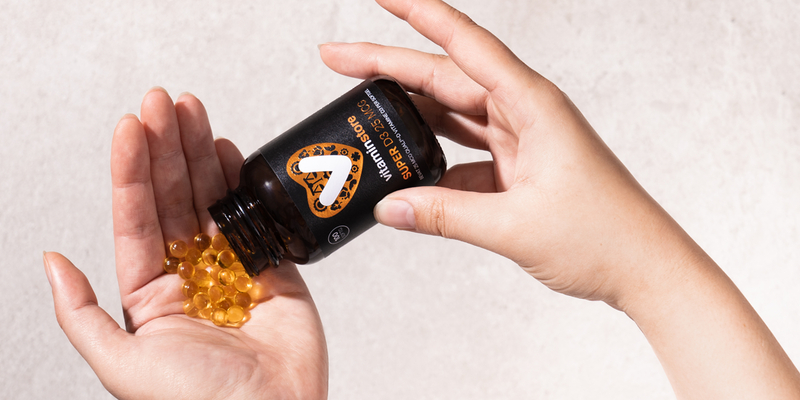
Folic Acid, Folate and 5-MTHF: What Are the Differences and Why Are They Important?
What is Folic Acid?
Folic acid is a synthetic form of vitamin B11. This vitamin is important for various bodily functions and is often used in supplements and fortified foods due to its stability. Unlike folate, the natural form found in food, folic acid is more resistant to heat and light, allowing it to retain its efficacy for longer.
What is Folic Acid Good For?
Folic acid plays a significant role in the body, such as supporting the production of red blood cells. Red blood cells transport oxygen throughout our body. Additionally, folic acid aids in the development of the foetus during pregnancy.1 Here's how it works.
Folic acid supplementation increases the folate status of the mother. A low folate status in the mother is a risk factor for the development of spina bifida in the growing foetus. Thus, folic acid plays an important role in the development of the neural tube of the foetus, which later forms the brain and spinal cord.
Everyone needs folic acid, but this is especially true for pregnant women. The Health Council therefore advises taking 400 micrograms of folic acid at least 4 weeks before pregnancy and continuing until the tenth week of pregnancy.2
Want to know more about the benefits of folic acid? Read our article All About Folic Acid.
What is the Difference Between Folic Acid and Folate?
The difference between folic acid and folate lies in their origin and form.3 Folate is the natural form of vitamin B11, found in unprocessed foods such as vegetables, fruits, and legumes. Folic acid, on the other hand, is the synthetic form used in supplements and fortified foods.
Folate is directly absorbed and utilised by the body, while folic acid must first be converted by the body into active forms of folate. This conversion occurs via an enzyme reaction that does not proceed equally efficiently in everyone. This can lead to an accumulation of folic acid in the body, which may have potential effects on your health.
What is 5-MTHF?
5-MTHF, or 5-methyltetrahydrofolate, is the most biologically active form of folate in the body. It is the form that can be directly used in processes within our cells.
To make folic acid usable, our body must go through 3 steps4:
Step 1: Folic acid is converted into a substance called dihydrofolate (DHF).
Step 2: DHF is then converted into tetrahydrofolate (THF).
Step 3: THF receives a methyl group and is converted into 5-methyltetrahydrofolate (5-MTHF), the active form that the body can use directly.
Why is 5-MTHF Important?
Some people have difficulty with these conversions. This can be due to genetic differences that prevent folic acid from going through the steps properly. For them, it is better to take 5-MTHF directly, which is already active and usable.
Because 5-MTHF is directly available for use, this form is increasingly seen in supplements. Especially for people who have trouble converting folic acid into active forms, this is important to consider.
How Do You Know If Your Body Has Trouble Converting Folate?
Difficulty in converting folate in the body can show small but important signs that are often overlooked. But how can you be sure?
If you suspect you have issues with folate conversion, it is advisable to discuss this with your doctor and undergo recommended additional testing. A specific diagnosis can only be made by a doctor or health professional.
1. Genetic Testing
Genetic variants, particularly in the MTHFR gene, can affect folate metabolism. A meta-analysis showed that certain MTHFR polymorphisms are associated with enzyme activity and reduced homocysteine levels.5
2. Blood Tests
Measuring different folate metabolites in serum, including 5-methyltetrahydrofolate (5-MTHF) and unmetabolised folic acid (UMFA), can provide insight into folate status and metabolism.6
3. Homocysteine Test
Elevated homocysteine levels can indicate a disrupted folate metabolism. A review confirmed the inverse relationship between folate status and homocysteine concentrations. An elevated homocysteine level can thus be an indicator of problems with folate conversion.7
Which Folic Acid Supplement is Best?
Choosing the right folic acid supplement depends on your personal needs and health condition. For most people, a supplement with natural folate or 5-MTHF is a better choice than synthetic folic acid. These forms are more easily absorbed by the body and do not require conversion efficiency.
Good to Know
It's good that you now know the difference between folic acid, folate, and 5-MTHF. Folic acid is the synthetic form often used in supplements, while folate is the natural form found in unprocessed foods. 5-MTHF is the active form of folate that can be directly used by the body.
For most people, it's better to choose a supplement with folate or 5-MTHF to achieve the best results. This form is directly usable by your body without various intermediate steps.
Do you have any questions? Our Health Coaches are ready to help you. Visit a store near you or ask your question in the chat.
Sources
- Greenberg, J. A., Bell, S. J., Guan, Y., & Yu, Y. H. (2011). Folic acid supplementation and pregnancy: more than just neural tube defect prevention. Reviews in obstetrics and gynecology, 4(2), 52.
- Health Council. (2021). Advisory on dietary recommendations for pregnant women. Health Council. Retrieved from https://www.gezondheidsraad.nl/binaries/gezondheidsraad/documenten/adviezen/2021/06/22/voedingsaanbevelingen-voor-zwangere-vrouwen/Advies-Voedingsaanbevelingen-voor-zwangere-vrouwen.pdf
- Scaglione, F., & Panzavolta, G. (2014). Folate, folic acid and 5-methyltetrahydrofolate are not the same thing. Xenobiotica, 44(5), 480-488.
- Agodi, A., Quattrocchi, A., Maugeri, A., & Barchitta, M. (2015). The link between MTHFR C677T polymorphism, folate metabolism and global DNA methylation: A literature review. Methylenetetrahydrofolate Reductase (MTHFR) in Health and Disease; Evans, R., Ed, 71-82.
- Liew, SC, & Gupta, ED (2015). Methylenetetrahydrofolate reductase (MTHFR) C677T polymorphism: epidemiology, metabolism and associated diseases. European Journal of Medical Genetics, 58(1), 1-10.
- Pfeiffer, CM, Sternberg, MR, Fazili, Z., Lacher, DA, Zhang, M., Johnson, CL, ... & Yetley, EA (2015). Folate status and concentrations of serum folate forms in the US population: National Health and Nutrition Examination Survey 2011–2. The American Journal of Clinical Nutrition, 102(6), 1450-1458.
- Liew, SC (2016). Folic acid and diseases: to supplement or not? Revista de Associação Médica Brasileira, 62, 90-100.








